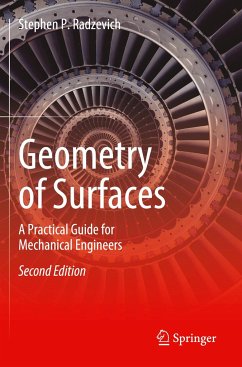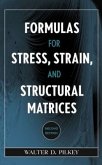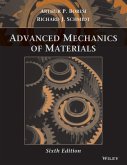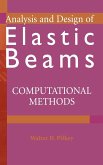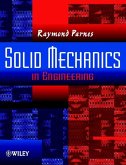- Broschiertes Buch
- Merkliste
- Auf die Merkliste
- Bewerten Bewerten
- Teilen
- Produkt teilen
- Produkterinnerung
- Produkterinnerung
This updated and expanded edition presents a highly accurate specification for part surface machining. Precise specification reduces the cost of this widely used industrial operation as accurately specified and machined part surfaces do not need to undergo costly final finishing. Dr. Radzevich describes techniques in this volume based primarily on classical differential geometry of surfaces. He then transitions from differential geometry of surfaces to engineering geometry of surfaces, and examines how part surfaces are either machined themselves, or are produced by tools with surfaces that…mehr
Andere Kunden interessierten sich auch für
![Geometry of Surfaces Geometry of Surfaces]() Stephen P. RadzevichGeometry of Surfaces95,99 €
Stephen P. RadzevichGeometry of Surfaces95,99 €![Geometry of Surfaces Geometry of Surfaces]() Stephen P. RadzevichGeometry of Surfaces170,99 €
Stephen P. RadzevichGeometry of Surfaces170,99 €![Introduction to Tribology Introduction to Tribology]() Bharat BhushanIntroduction to Tribology192,99 €
Bharat BhushanIntroduction to Tribology192,99 €![Formulas for Stress, Strain, and Structural Matrices Formulas for Stress, Strain, and Structural Matrices]() Walter D. PilkeyFormulas for Stress, Strain, and Structural Matrices268,99 €
Walter D. PilkeyFormulas for Stress, Strain, and Structural Matrices268,99 €![Advanced Mechanics of Materials Advanced Mechanics of Materials]() Arthur P. BoresiAdvanced Mechanics of Materials429,99 €
Arthur P. BoresiAdvanced Mechanics of Materials429,99 €![Elastic Beams w/WS Elastic Beams w/WS]() Walter D. PilkeyElastic Beams w/WS163,99 €
Walter D. PilkeyElastic Beams w/WS163,99 €![Solid Mechanics in Engineering Solid Mechanics in Engineering]() Raymond ParnesSolid Mechanics in Engineering103,99 €
Raymond ParnesSolid Mechanics in Engineering103,99 €-
-
-
This updated and expanded edition presents a highly accurate specification for part surface machining. Precise specification reduces the cost of this widely used industrial operation as accurately specified and machined part surfaces do not need to undergo costly final finishing. Dr. Radzevich describes techniques in this volume based primarily on classical differential geometry of surfaces. He then transitions from differential geometry of surfaces to engineering geometry of surfaces, and examines how part surfaces are either machined themselves, or are produced by tools with surfaces that are precisely machined. The book goes on to explain specific methods, such as derivation of planar characteristic curves based on Plücker conoid constructed at a point of the part surface, and that analytical description of part surface is vital for surfaces machined using CNC technology, and especially so for multi-axes NC machines. Providing readers with a powerful tool for analytical description of part surfaces machined on conventional machine tools and numerically controlled machines, this book maximizes understanding on optimal treatment of part surfaces to meet the requirements of today's high tech industry.
Produktdetails
- Produktdetails
- Verlag: Springer / Springer International Publishing / Springer, Berlin
- Artikelnr. des Verlages: 978-3-030-22186-7
- 2. Aufl.
- Seitenzahl: 332
- Erscheinungstermin: 30. August 2020
- Englisch
- Abmessung: 235mm x 155mm x 19mm
- Gewicht: 505g
- ISBN-13: 9783030221867
- ISBN-10: 3030221865
- Artikelnr.: 59921566
- Verlag: Springer / Springer International Publishing / Springer, Berlin
- Artikelnr. des Verlages: 978-3-030-22186-7
- 2. Aufl.
- Seitenzahl: 332
- Erscheinungstermin: 30. August 2020
- Englisch
- Abmessung: 235mm x 155mm x 19mm
- Gewicht: 505g
- ISBN-13: 9783030221867
- ISBN-10: 3030221865
- Artikelnr.: 59921566
Dr. Stephen P. Radzevich is a Professor of Mechanical Engineering, and a Professor of Manufacturing Engineering. He received the M.Sc. (1976), the Ph.D. (1982), and the Dr.(Eng)Sc. (1991) - all in mechanical engineering. Dr. Radzevich has extensive industrial experience in gear design and manufacture. He has developed numerous software packages dealing with CAD and CAM of precise gear finishing for a variety of industrial sponsors. His main research interest is Kinematic Geometry of Surface Generation, particularly with the focus on (a) precision gear design, (b) high power density gear trains, (c) torque share in multi-flow gear trains, (d) design of special purpose gear cutting/finishing tools, (e) design and machining (finishing) of precision gears for low-noise/noiseless transmissions of cars, light trucks etc. Dr. Radzevich has spent about 40 years developing software, hardware and other processes for gear design an optimization. Besides his work for industry, he trains engineering students at universities and gear engineers in companies. He authored and co-authored over 30 monographs, handbooks, and textbooks. The monographs entitled " Generation of Surfaces" (2001), "Kinematic Geometry of Surface Machining" ( CRC Press, 2008), "CAD/CAM of Sculptured Surfaces on Multi-Axis NC Machine: The DG/K-Based Approach" (M&C Publishers, 2008), "Gear Cutting Tools: Fundamentals of Design and Computation" (CRC Press, 2010, 2nd edition 2017), "Precision Gear Shaving" (Nova Science Publishers, 2010), "Dudley's Handbook of Practical Gear Design and Manufacture" (CRC Press, 2012, 2nd edition 2016), "Theory of Gearing: Kinematics, Geometry, and Synthesis" ( CRC Press, 2012, 2nd edition 2018), "Geometry of Surfaces: A Practical Guide for Mechanical Engineers" (2013) are among the recently published volumes. He also authored and co-authored about 350 scientific papers and holds over 250 patents on inventions in the field, both, USA patents and International.
Part 1. Part Surfaces.- Geometry of a Part Surface.- On a Possibility of Classification of Part Surfaces.- Part 2. On a Possibility of Classification of Part Surfaces.- Early Works in the Field of Contact Geometry of Surfaces.- An Analytical Method based on Second Fundamental Forms of the Contacting Part Surfaces.- Indicatrix of Conformity at Point of Contact of Two Smooth Regular Part Surfaces in the First Order of Tangency.- Plücker Conoid: More Characteristic Curves.- Possible Kinds of Contact of Two Smooth Regular Part Surfaces in the First Order of Tangency.- Part 3. Mapping of Contacting Part Surfaces.- -Mapping of Interacting Part Surfaces.- Generation of Enveloping Surfaces: General Consideration.- Generation of Enveloping Surfaces: Special Cases.- Conclusion.- Appendix A: Elements of Vector Calculus.- Appendix B: Elements of Coordinate Systems Transformations.- Appendix C: Change of Surface Parameters.- Appendix D: Closest Distance of Approach between Two Part Surfaces.
About the Author xiii Preface xv Acknowledgments xvii Glossary xix Notation
xxi Introduction xxv Part I PART SURFACES 1 1 Geometry of a Part Surface 3
1.1 On the Analytical Description of Ideal Surfaces 3 1.2 On the Difference
between Classical Differential Geometry and Engineering Geometry of
Surfaces 6 1.3 On the Analytical Description of Part Surfaces 7 1.4
Boundary Surfaces for an Actual Part Surface 9 1.5 Natural Representation
of a Desired Part Surface 11 1.6 Elements of Local Geometry of a Desired
Part Surface 19 2 On the Possibility of Classification of Part Surfaces 27
2.1 Sculptured Part Surfaces 27 2.2 Planar Characteristic Images 33 2.3
Circular Diagrams at a Surface Point 42 2.4 One More Useful Characteristic
Curve 53 Part II GEOMETRY OF CONTACT OF PART SURFACES 55 3 Early Works in
the Field of Contact Geometry 57 3.1 Order of Contact 57 3.2 Contact
Geometry of Part Surfaces 59 3.3 Local Relative Orientation of the
Contacting Part Surfaces 59 3.4 First-Order Analysis: Common Tangent Plane
64 3.5 Second-Order Analysis 65 3.6 A Characteristic Curve Irk (R ) of
Novel Kind 75 4 An Analytical Method Based on Second Fundamental Forms of
the Contacting Part Surfaces 79 5 Indicatrix of Conformity of Two Smooth
Regular Surfaces in the First Order of Tangency 83 5.1 Preliminary Remarks
83 5.2 Indicatrix of Conformity for Two Smooth Regular Part Surfaces in the
First Order of Tangency 87 5.3 Directions of Extremum Degree of Conformity
of Two Part Surfaces in Contact 94 5.4 Asymptotes of the Indicatrix of
Conformity CnfR (P1/P2) 97 5.5 Comparison of Capabilities of Indicatrix of
Conformity Cnf R(P1/P2) and of Dupin Indicatrix of the Surface of Relative
Curvature Dup (R) 98 5.6 Important Properties of Indicatrix of Conformity
Cnf R(P/T ) of Two Smooth Regular Part Surfaces 99 5.7 The Converse
Indicatrix of Conformity of Two Regular Part Surfaces in the First Order of
Tangency 99 6 Plücker Conoid: More Characteristic Curves 101 6.1 Plücker
Conoid 101 6.2 On Analytical Description of Local Geometry of a Smooth
Regular Part Surface 105 6.3 Relative Characteristic Curve 112 7 Feasible
Kinds of Contact of Two Smooth Regular Part Surfaces in the First Order of
Tangency 117 7.1 On the Possibility of Implementation of the Indicatrix of
Conformity for the Purposes of Identification of the Actual Kind of Contact
of Two Smooth Regular Part Surfaces 117 7.2 Impact of Accuracy of the
Computation on the Parameters of the Indicatrices of Conformity Cnf
R(P1/P2) 121 7.3 Classification of Possible Kinds of Contact of Two Smooth
Regular Part Surfaces 122 Part III MAPPING OF THE CONTACTING PART SURFACES
131 8 R-Mapping of the Interacting Part Surfaces 133 8.1 Preliminary
Remarks 133 8.2 On the Concept of R-Mapping of the Interacting Part
Surfaces 134 8.3 R-mapping of a Part Surface P1 onto Another Part Surface
P2 136 8.4 Reconstruction of the Mapped Part Surface 140 8.5 Illustrative
Examples of the Calculation of the Design Parameters of the Mapped Part
Surface 141 9 Generation of Enveloping Surfaces: General Consideration 145
9.1 Envelope for Successive Positions of a Moving Planar Curve 145 9.2
Envelope for Successive Positions of a Moving Surface 149 9.3 Kinematic
Method for Determining Enveloping Surfaces 154 9.4 Peculiarities of
Implementation of the Kinematic Method in Cases of Multi-parametric
Relative Motion of the Surfaces 164 10 Generation of Enveloping Surfaces:
Special Cases 167 10.1 Part Surfaces that Allow for Sliding Over Themselves
167 10.2 Reversibly Enveloping Surfaces: Introductory Remarks 169 10.3
Generation of Reversibly Enveloping Surfaces 180 10.4 On the Looseness of
Two Olivier Principles 197 Conclusion 203 APPENDICES 205 Appendix A:
Elements of Vector Calculus 207 A.1 Fundamental Properties of Vectors 207
A.2 Mathematical Operations over Vectors 207 Appendix B: Elements of
Coordinate System Transformations 211 B.1 Coordinate System Transformation
211 B.2 Conversion of the Coordinate System Orientation 222 B.3
Transformation of Surface Fundamental Forms 223 Appendix C: Change of
Surface Parameters 225 References 227 Bibliography 229 Index 233
xxi Introduction xxv Part I PART SURFACES 1 1 Geometry of a Part Surface 3
1.1 On the Analytical Description of Ideal Surfaces 3 1.2 On the Difference
between Classical Differential Geometry and Engineering Geometry of
Surfaces 6 1.3 On the Analytical Description of Part Surfaces 7 1.4
Boundary Surfaces for an Actual Part Surface 9 1.5 Natural Representation
of a Desired Part Surface 11 1.6 Elements of Local Geometry of a Desired
Part Surface 19 2 On the Possibility of Classification of Part Surfaces 27
2.1 Sculptured Part Surfaces 27 2.2 Planar Characteristic Images 33 2.3
Circular Diagrams at a Surface Point 42 2.4 One More Useful Characteristic
Curve 53 Part II GEOMETRY OF CONTACT OF PART SURFACES 55 3 Early Works in
the Field of Contact Geometry 57 3.1 Order of Contact 57 3.2 Contact
Geometry of Part Surfaces 59 3.3 Local Relative Orientation of the
Contacting Part Surfaces 59 3.4 First-Order Analysis: Common Tangent Plane
64 3.5 Second-Order Analysis 65 3.6 A Characteristic Curve Irk (R ) of
Novel Kind 75 4 An Analytical Method Based on Second Fundamental Forms of
the Contacting Part Surfaces 79 5 Indicatrix of Conformity of Two Smooth
Regular Surfaces in the First Order of Tangency 83 5.1 Preliminary Remarks
83 5.2 Indicatrix of Conformity for Two Smooth Regular Part Surfaces in the
First Order of Tangency 87 5.3 Directions of Extremum Degree of Conformity
of Two Part Surfaces in Contact 94 5.4 Asymptotes of the Indicatrix of
Conformity CnfR (P1/P2) 97 5.5 Comparison of Capabilities of Indicatrix of
Conformity Cnf R(P1/P2) and of Dupin Indicatrix of the Surface of Relative
Curvature Dup (R) 98 5.6 Important Properties of Indicatrix of Conformity
Cnf R(P/T ) of Two Smooth Regular Part Surfaces 99 5.7 The Converse
Indicatrix of Conformity of Two Regular Part Surfaces in the First Order of
Tangency 99 6 Plücker Conoid: More Characteristic Curves 101 6.1 Plücker
Conoid 101 6.2 On Analytical Description of Local Geometry of a Smooth
Regular Part Surface 105 6.3 Relative Characteristic Curve 112 7 Feasible
Kinds of Contact of Two Smooth Regular Part Surfaces in the First Order of
Tangency 117 7.1 On the Possibility of Implementation of the Indicatrix of
Conformity for the Purposes of Identification of the Actual Kind of Contact
of Two Smooth Regular Part Surfaces 117 7.2 Impact of Accuracy of the
Computation on the Parameters of the Indicatrices of Conformity Cnf
R(P1/P2) 121 7.3 Classification of Possible Kinds of Contact of Two Smooth
Regular Part Surfaces 122 Part III MAPPING OF THE CONTACTING PART SURFACES
131 8 R-Mapping of the Interacting Part Surfaces 133 8.1 Preliminary
Remarks 133 8.2 On the Concept of R-Mapping of the Interacting Part
Surfaces 134 8.3 R-mapping of a Part Surface P1 onto Another Part Surface
P2 136 8.4 Reconstruction of the Mapped Part Surface 140 8.5 Illustrative
Examples of the Calculation of the Design Parameters of the Mapped Part
Surface 141 9 Generation of Enveloping Surfaces: General Consideration 145
9.1 Envelope for Successive Positions of a Moving Planar Curve 145 9.2
Envelope for Successive Positions of a Moving Surface 149 9.3 Kinematic
Method for Determining Enveloping Surfaces 154 9.4 Peculiarities of
Implementation of the Kinematic Method in Cases of Multi-parametric
Relative Motion of the Surfaces 164 10 Generation of Enveloping Surfaces:
Special Cases 167 10.1 Part Surfaces that Allow for Sliding Over Themselves
167 10.2 Reversibly Enveloping Surfaces: Introductory Remarks 169 10.3
Generation of Reversibly Enveloping Surfaces 180 10.4 On the Looseness of
Two Olivier Principles 197 Conclusion 203 APPENDICES 205 Appendix A:
Elements of Vector Calculus 207 A.1 Fundamental Properties of Vectors 207
A.2 Mathematical Operations over Vectors 207 Appendix B: Elements of
Coordinate System Transformations 211 B.1 Coordinate System Transformation
211 B.2 Conversion of the Coordinate System Orientation 222 B.3
Transformation of Surface Fundamental Forms 223 Appendix C: Change of
Surface Parameters 225 References 227 Bibliography 229 Index 233
Part 1. Part Surfaces.- Geometry of a Part Surface.- On a Possibility of Classification of Part Surfaces.- Part 2. On a Possibility of Classification of Part Surfaces.- Early Works in the Field of Contact Geometry of Surfaces.- An Analytical Method based on Second Fundamental Forms of the Contacting Part Surfaces.- Indicatrix of Conformity at Point of Contact of Two Smooth Regular Part Surfaces in the First Order of Tangency.- Plücker Conoid: More Characteristic Curves.- Possible Kinds of Contact of Two Smooth Regular Part Surfaces in the First Order of Tangency.- Part 3. Mapping of Contacting Part Surfaces.- -Mapping of Interacting Part Surfaces.- Generation of Enveloping Surfaces: General Consideration.- Generation of Enveloping Surfaces: Special Cases.- Conclusion.- Appendix A: Elements of Vector Calculus.- Appendix B: Elements of Coordinate Systems Transformations.- Appendix C: Change of Surface Parameters.- Appendix D: Closest Distance of Approach between Two Part Surfaces.
About the Author xiii Preface xv Acknowledgments xvii Glossary xix Notation
xxi Introduction xxv Part I PART SURFACES 1 1 Geometry of a Part Surface 3
1.1 On the Analytical Description of Ideal Surfaces 3 1.2 On the Difference
between Classical Differential Geometry and Engineering Geometry of
Surfaces 6 1.3 On the Analytical Description of Part Surfaces 7 1.4
Boundary Surfaces for an Actual Part Surface 9 1.5 Natural Representation
of a Desired Part Surface 11 1.6 Elements of Local Geometry of a Desired
Part Surface 19 2 On the Possibility of Classification of Part Surfaces 27
2.1 Sculptured Part Surfaces 27 2.2 Planar Characteristic Images 33 2.3
Circular Diagrams at a Surface Point 42 2.4 One More Useful Characteristic
Curve 53 Part II GEOMETRY OF CONTACT OF PART SURFACES 55 3 Early Works in
the Field of Contact Geometry 57 3.1 Order of Contact 57 3.2 Contact
Geometry of Part Surfaces 59 3.3 Local Relative Orientation of the
Contacting Part Surfaces 59 3.4 First-Order Analysis: Common Tangent Plane
64 3.5 Second-Order Analysis 65 3.6 A Characteristic Curve Irk (R ) of
Novel Kind 75 4 An Analytical Method Based on Second Fundamental Forms of
the Contacting Part Surfaces 79 5 Indicatrix of Conformity of Two Smooth
Regular Surfaces in the First Order of Tangency 83 5.1 Preliminary Remarks
83 5.2 Indicatrix of Conformity for Two Smooth Regular Part Surfaces in the
First Order of Tangency 87 5.3 Directions of Extremum Degree of Conformity
of Two Part Surfaces in Contact 94 5.4 Asymptotes of the Indicatrix of
Conformity CnfR (P1/P2) 97 5.5 Comparison of Capabilities of Indicatrix of
Conformity Cnf R(P1/P2) and of Dupin Indicatrix of the Surface of Relative
Curvature Dup (R) 98 5.6 Important Properties of Indicatrix of Conformity
Cnf R(P/T ) of Two Smooth Regular Part Surfaces 99 5.7 The Converse
Indicatrix of Conformity of Two Regular Part Surfaces in the First Order of
Tangency 99 6 Plücker Conoid: More Characteristic Curves 101 6.1 Plücker
Conoid 101 6.2 On Analytical Description of Local Geometry of a Smooth
Regular Part Surface 105 6.3 Relative Characteristic Curve 112 7 Feasible
Kinds of Contact of Two Smooth Regular Part Surfaces in the First Order of
Tangency 117 7.1 On the Possibility of Implementation of the Indicatrix of
Conformity for the Purposes of Identification of the Actual Kind of Contact
of Two Smooth Regular Part Surfaces 117 7.2 Impact of Accuracy of the
Computation on the Parameters of the Indicatrices of Conformity Cnf
R(P1/P2) 121 7.3 Classification of Possible Kinds of Contact of Two Smooth
Regular Part Surfaces 122 Part III MAPPING OF THE CONTACTING PART SURFACES
131 8 R-Mapping of the Interacting Part Surfaces 133 8.1 Preliminary
Remarks 133 8.2 On the Concept of R-Mapping of the Interacting Part
Surfaces 134 8.3 R-mapping of a Part Surface P1 onto Another Part Surface
P2 136 8.4 Reconstruction of the Mapped Part Surface 140 8.5 Illustrative
Examples of the Calculation of the Design Parameters of the Mapped Part
Surface 141 9 Generation of Enveloping Surfaces: General Consideration 145
9.1 Envelope for Successive Positions of a Moving Planar Curve 145 9.2
Envelope for Successive Positions of a Moving Surface 149 9.3 Kinematic
Method for Determining Enveloping Surfaces 154 9.4 Peculiarities of
Implementation of the Kinematic Method in Cases of Multi-parametric
Relative Motion of the Surfaces 164 10 Generation of Enveloping Surfaces:
Special Cases 167 10.1 Part Surfaces that Allow for Sliding Over Themselves
167 10.2 Reversibly Enveloping Surfaces: Introductory Remarks 169 10.3
Generation of Reversibly Enveloping Surfaces 180 10.4 On the Looseness of
Two Olivier Principles 197 Conclusion 203 APPENDICES 205 Appendix A:
Elements of Vector Calculus 207 A.1 Fundamental Properties of Vectors 207
A.2 Mathematical Operations over Vectors 207 Appendix B: Elements of
Coordinate System Transformations 211 B.1 Coordinate System Transformation
211 B.2 Conversion of the Coordinate System Orientation 222 B.3
Transformation of Surface Fundamental Forms 223 Appendix C: Change of
Surface Parameters 225 References 227 Bibliography 229 Index 233
xxi Introduction xxv Part I PART SURFACES 1 1 Geometry of a Part Surface 3
1.1 On the Analytical Description of Ideal Surfaces 3 1.2 On the Difference
between Classical Differential Geometry and Engineering Geometry of
Surfaces 6 1.3 On the Analytical Description of Part Surfaces 7 1.4
Boundary Surfaces for an Actual Part Surface 9 1.5 Natural Representation
of a Desired Part Surface 11 1.6 Elements of Local Geometry of a Desired
Part Surface 19 2 On the Possibility of Classification of Part Surfaces 27
2.1 Sculptured Part Surfaces 27 2.2 Planar Characteristic Images 33 2.3
Circular Diagrams at a Surface Point 42 2.4 One More Useful Characteristic
Curve 53 Part II GEOMETRY OF CONTACT OF PART SURFACES 55 3 Early Works in
the Field of Contact Geometry 57 3.1 Order of Contact 57 3.2 Contact
Geometry of Part Surfaces 59 3.3 Local Relative Orientation of the
Contacting Part Surfaces 59 3.4 First-Order Analysis: Common Tangent Plane
64 3.5 Second-Order Analysis 65 3.6 A Characteristic Curve Irk (R ) of
Novel Kind 75 4 An Analytical Method Based on Second Fundamental Forms of
the Contacting Part Surfaces 79 5 Indicatrix of Conformity of Two Smooth
Regular Surfaces in the First Order of Tangency 83 5.1 Preliminary Remarks
83 5.2 Indicatrix of Conformity for Two Smooth Regular Part Surfaces in the
First Order of Tangency 87 5.3 Directions of Extremum Degree of Conformity
of Two Part Surfaces in Contact 94 5.4 Asymptotes of the Indicatrix of
Conformity CnfR (P1/P2) 97 5.5 Comparison of Capabilities of Indicatrix of
Conformity Cnf R(P1/P2) and of Dupin Indicatrix of the Surface of Relative
Curvature Dup (R) 98 5.6 Important Properties of Indicatrix of Conformity
Cnf R(P/T ) of Two Smooth Regular Part Surfaces 99 5.7 The Converse
Indicatrix of Conformity of Two Regular Part Surfaces in the First Order of
Tangency 99 6 Plücker Conoid: More Characteristic Curves 101 6.1 Plücker
Conoid 101 6.2 On Analytical Description of Local Geometry of a Smooth
Regular Part Surface 105 6.3 Relative Characteristic Curve 112 7 Feasible
Kinds of Contact of Two Smooth Regular Part Surfaces in the First Order of
Tangency 117 7.1 On the Possibility of Implementation of the Indicatrix of
Conformity for the Purposes of Identification of the Actual Kind of Contact
of Two Smooth Regular Part Surfaces 117 7.2 Impact of Accuracy of the
Computation on the Parameters of the Indicatrices of Conformity Cnf
R(P1/P2) 121 7.3 Classification of Possible Kinds of Contact of Two Smooth
Regular Part Surfaces 122 Part III MAPPING OF THE CONTACTING PART SURFACES
131 8 R-Mapping of the Interacting Part Surfaces 133 8.1 Preliminary
Remarks 133 8.2 On the Concept of R-Mapping of the Interacting Part
Surfaces 134 8.3 R-mapping of a Part Surface P1 onto Another Part Surface
P2 136 8.4 Reconstruction of the Mapped Part Surface 140 8.5 Illustrative
Examples of the Calculation of the Design Parameters of the Mapped Part
Surface 141 9 Generation of Enveloping Surfaces: General Consideration 145
9.1 Envelope for Successive Positions of a Moving Planar Curve 145 9.2
Envelope for Successive Positions of a Moving Surface 149 9.3 Kinematic
Method for Determining Enveloping Surfaces 154 9.4 Peculiarities of
Implementation of the Kinematic Method in Cases of Multi-parametric
Relative Motion of the Surfaces 164 10 Generation of Enveloping Surfaces:
Special Cases 167 10.1 Part Surfaces that Allow for Sliding Over Themselves
167 10.2 Reversibly Enveloping Surfaces: Introductory Remarks 169 10.3
Generation of Reversibly Enveloping Surfaces 180 10.4 On the Looseness of
Two Olivier Principles 197 Conclusion 203 APPENDICES 205 Appendix A:
Elements of Vector Calculus 207 A.1 Fundamental Properties of Vectors 207
A.2 Mathematical Operations over Vectors 207 Appendix B: Elements of
Coordinate System Transformations 211 B.1 Coordinate System Transformation
211 B.2 Conversion of the Coordinate System Orientation 222 B.3
Transformation of Surface Fundamental Forms 223 Appendix C: Change of
Surface Parameters 225 References 227 Bibliography 229 Index 233

